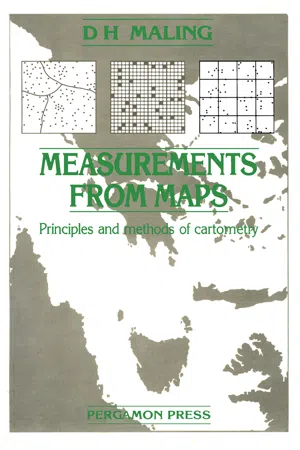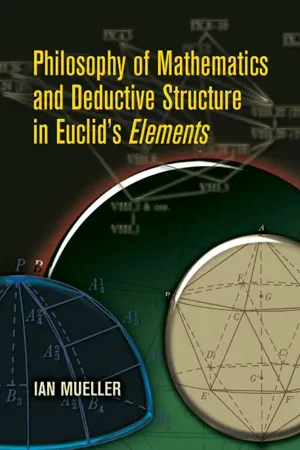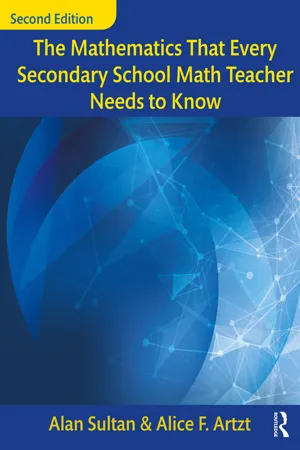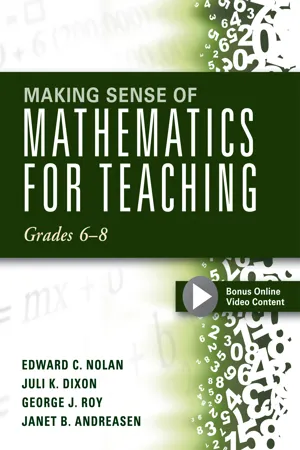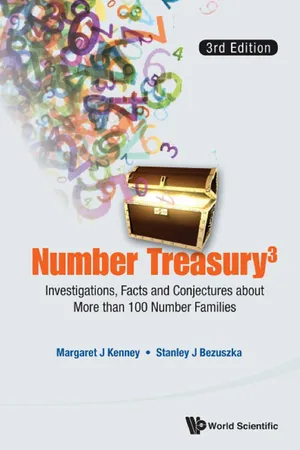Mathematics
Area of Plane Figures
The area of plane figures refers to the measure of the space enclosed by a two-dimensional shape, such as a square, rectangle, triangle, or circle. It is calculated by using specific formulas for each shape, such as base times height for a triangle or side squared for a square. Understanding the concept of area is essential for solving geometric problems and real-world applications.
Written by Perlego with AI-assistance
Related key terms
1 of 5
7 Key excerpts on "Area of Plane Figures"
- eBook - PDF
Measurements from Maps
Principles and Methods of Cartometry
- D H Maling(Author)
- 2016(Publication Date)
- Butterworth-Heinemann(Publisher)
Using modern methods of data collection and storage there is no reason why they should not be used to measure the area enclosed by a coastline or other irregular boundary, even if this comprises many hundreds of thousands of separate coordinated points. 328 Measurements from Maps THE AREA FORMULAE OF PLANE GEOMETRY The formulae which follow are presented without proof, for all of them are well known and they are listed here to remind the reader how each of the measurements and calculations are made. The Area of a Triangle Figure 16.1(a) illustrates a triangle ABC in which one side is designated the base, b, and the line perpendicular to it which passes through the opposite vertex is called the height, h. Then, the area, A=b-h (16.1) If any of the angles of the triangle are also known, alternative solutions are A=absinC (16.2) (e) ( f ) FIG. 16.1. Measurement of area of simple plane figures according to the rules of Euclidean geometry: (a) the triangle ABC; (b) the rectangle ABCD; (c) the parallelo-gram ABCD; (d) the rhombus ABCD; (e) the trapezoid, ABCD; (f) any quadrilateral ABCD. Geometrical Methods of Area Measurement 329 (16.3) A =jbc'unA (16.4) For a triangle in which the perpendicular height had not been determined, and the angles have not been measured, but the lengths of all three sides are known, the half-perimeter formula may be used A = y J { s (s-a){s-b)(s-c)} (16.5) where s = ^ a + b + c) (16.6) or is one-half of the length of the perimeter of the figure. The Area of a Rectangle In Fig. 16.1(b) the rectangle ABCD has the sides AB = a and BC = b. Quite simply. A = a-b (16.7) The Area of a Parallelogram In Fig. 16.1(c) the figure has side AB = a and BC = b. Also h is the length of the perpendicular to one pair of the parallel sides. Then A = ah (16.8) Also A = abs'mB (16.9) The Area of a Rhombus The length of each side of the figure is equal to a. - Ian Mueller(Author)
- 2013(Publication Date)
- Dover Publications(Publisher)
4Proportion and the Geometry of Plane Rectilineal Figures
Among the elementary facts of traditional geometry are formulas for computing the areas and volumes of figures on the basis of certain lengths. For example, The area of a parallelogram is the product of its base and its height;The area of a triangle is of the product of its base and its height.Knowledge of such formulas can be traced with reasonable probability to a period long before classical Greek civilization.1 The fact that such formulas are not to be found in the Elements or in other mathematical works of the third century is obviously not due to ignorance. To understand why these formulas are not found in the Elements one must first understand what conceptual apparatus would be required in a satisfactory proof of their validity.Clearly, the first thing needed is a number system with multiplication and a way of assigning numbers to lines and figures. But to assign a number to a line is not to make an abstract correlation; it is to say that the line has a certain length. Hence the formulas for areas presuppose a notion of signed quantities. A straight line is not 9 but 9 centimeters in length; a triangle is not 3 but 3 square meters in area, and so on. Obviously one needs as well an understanding of the relations between signed quantities; for example, one needs to know that the product of a length in meters and a length in meters is an area in square meters. Finally, it seems, one needs to understand notions like length, area, and volume abstractly. A figure isn’t an area; it has an area, an area which another figure might have as well.I have already indicated the general absence of abstract notions in Euclid’s geometry. The absence of the other concepts underlying the standard geometric formulas does not need to be documented. The assignment of numbers to geometric objects and, therefore, signed quantities are simply not to be found in the Elements.- Alan Sultan, Alice F. Artzt(Authors)
- 2017(Publication Date)
- Routledge(Publisher)
Chapter 4Measurement: Area and Volume4.1 IntroductionStarting in elementary school, children learn about such important concepts in measurement as area and volume. These are measures that are used in our lives on a daily basis. For example, we buy carpeting according to square footage and this is a measure of area. We buy paint according to the area of the surface that must be covered. We buy milk by the quart, which is a measure of volume, and we build tanks to hold gallons of oil, another measure of volume. These are just a few of many, many applications of area and volume that are used in various fields on a day-to-day basis. In this chapter we take a closer look at these concepts by linking basic geometry, algebra, trigonometry, probability, and the rudiments of calculus together with modern technology.Since we want to stress some extremely interesting approaches and relationships involved in area and volume, we will avoid a strict formal approach and we will assume that you accept certain facts such as the following: congruent figures have congruent areas; parallel lines are everywhere equidistant; and regular polygons with an increasing number of sides inscribed in a fixed circle of radius r have areas approaching the area of a circle. Afterwards, we discuss some of the issues with this mostly informal approach and the need for axiomatizing certain relationships. Before we begin, we say a few things about notation.Throughout the remainder of this book, when we write AB = DE , it will mean that the lengths ofandA B¯D E¯(line segments AB and DE ) are the same, and when we write∡ A = ∡ Dit means that angles A and D have the same measure.4.2 Areas of Simple Figures and Some Surprising ConsequencesLaunch- 1 Show, using a picture, that the area of a rectangle with sides 2 inches wide and 3 inches long has an area of 6 square units. [Hint: divide the rectangle into square inches.]
- eBook - PDF
- John Peterson, Robert Smith(Authors)
- 2019(Publication Date)
- Cengage Learning EMEA(Publisher)
437 Geometric Figures: Areas and Volumes 6 OBJECTIVES After studying this unit you should be able to ● ● Express given customary area measures in larger and smaller units. ● ● Express given metric area measures in larger and smaller units. ● ● Convert between customary area measures and metric area measures. ● ● Compute areas, lengths, and widths of rectangles. ● ● Compute areas, bases, and heights of parallelograms. ● ● Compute areas, both bases, and heights of trapezoids. ● ● Compute areas of more complex figures (composite figures) that consist of two or more common polygons. As previously stated, in machine technology linear or length measure is used more often than area and volume measure. However, the ability to compute areas and volumes is required in determining job-material quantities and costs. Often, before a product is manufactured, part weights are computed. Volumes of simple geometric figures and combinations of figures (composite figures) must be calculated before weights can be determined. Section 6 presents area and volume measure of two-dimensional and three-dimensional geometric figures and practical area and volume applications. Areas of Rectangles, Parallelograms, and Trapezoids UNIT 59 CUSTOMARY AND METRIC UNITS OF SURFACE MEASURE (AREA) A surface is measured by determining the number of surface units contained in it. A surface is two dimensional. It has a length and width, but no thickness. Both length and width must be expressed in the same unit of measure. Area is computed as the SECTION SIX 438 SECTION 6 GEOMETRIC FIGURES: AREAS AND VOLUMES product of two linear measures and is expressed in square units. For example, 2 inches 3 4 inches 5 8 square inches (8 sq in. or 8 in. 2 ). The surface enclosed by a square that is 1 inch on a side is 1 square inch (1 sq in. or 1 in. 2 ). The surface enclosed by a square that is 1 foot on a side is 1 square foot (1 sq ft or 1 ft 2 ). - eBook - ePub
Making Sense of Mathematics for Teaching Grades 6-8
(Unifying Topics for an Understanding of Functions, Statistics, and Probability)
- Edward C. Nolan, Juli K. Dixon(Authors)
- 2016(Publication Date)
- Solution Tree Press(Publisher)
As students progress through elementary-grades and middle-grades mathematics, composing and decomposing shapes deepens their understanding of area and leads to the development of understanding surface area and volume. Parallel to the development of understanding geometric measurement is the development of underlying geometry concepts, which continually connects to other areas of mathematics, such as fractions, ratios, and proportions. Students begin to use the coordinate plane for representing algebraic models and connect to similar triangles, scale factor, and slope. Properties and classifications of shapes are expanded to include properties of parallel lines, congruent and similar shapes, and the Pythagorean theorem.Grade 6
As students transition to the middle grades, they bring the conceptual development of the meaning of area as the number of square units used to cover a shape completely with no gaps or overlaps, particularly applied to rectangles and connected to multiplication and rectangular arrays. In grade 6, students build on their understandings from the elementary grades to determine the areas of different shapes, including triangles (right and otherwise), additional special quadrilaterals (kite, parallelogram, rhombus, and trapezoid), and other polygons. Students apply their understandings of area to solve real-world problems. Shapes are also drawn on the coordinate plane, and this structure is used to determine dimensions in order to solve problems.Similarly, student understanding of volume from the elementary grades is primarily related to the number of cubic units that fill a prism. This understanding is expanded in the middle grades to right rectangular prisms with fractional dimensions (students determine area of rectangles involving fractional dimensions in grade 5). Students examine nets of three-dimensional solids, including prisms and pyramids, and develop an understanding of surface area.Grade 7
Geometric understandings in grade 7 connect to prior knowledge of shapes and proportional reasoning to create scale drawings and to determine dimensions from scale drawings. Students use their understanding of shapes to consider which shapes can be formed based on given information, including determining when the given information allows for only one possible shape and when multiple shapes can be created from that information. For example, what shapes can be drawn that have two sets of parallel sides? What if the shapes are limited to quadrilaterals? How does that change what shapes can be included? Students’ spatial visualization is further developed as they find two-dimensional cross sections of three-dimensional objects. - eBook - PDF
- Richard Aufmann, Joanne Lockwood, Richard Nation, Daniel K. Clegg(Authors)
- 2017(Publication Date)
- Cengage Learning EMEA(Publisher)
355 7.1 Measurement 7.2 Basic Concepts of Euclidean Geometry 7.3 Perimeter and Area of Plane Figures 7.4 Properties of Triangles 7.5 Volume and Surface Area 7.6 Right Triangle Trigonometry 7.7 Non-Euclidean Geometry 7.8 Fractals Measurement and Geometry Much of this chapter concerns geometric figures and their properties. Drawing complex 3D figures by hand can be tedious and time consuming. Fortunately, the advent of 3D com- puter drawing programs has made the process much easier. One of the easiest 3D drawing programs to use is Google SketchUp. If you are not familiar with SketchUp, we encourage you to give it a try. A free version is available at http://sketchup.google.com/. Even if you decide not to produce your own 3D drawings, you can still enjoy looking at some of the drawings that other SketchUp users have produced. For example, the following SketchUp drawing of a country villa incorporates many of the geometric figures presented in this chapter. After you download this draw- ing 1 , you can use rotation and zoom tools to view the villa from any angle and distance. Use the rotation and zoom tools to check out the grand piano on the second floor. Google SketchUp™/josh86 3D drawing programs have been used to design video games. For instance, art director Robh Ruppel used SketchUp to design the video game Uncharted 2: Among Thieves. He discusses some of the details concerning the design of Uncharted 2 in a YouTube video available at http://www.youtube.com/ watch?v=8mkPRmqUlFw. 1 The URL for the above country villa drawing is: http://sketchup.google.com/3dwarehouse/ details?mid=79a4f741cbf41e86a1c299db94b0d06b&prevstart=0 7 Sony Corporation of America. Copyright 2018 Cengage Learning. All Rights Reserved. May not be copied, scanned, or duplicated, in whole or in part. Due to electronic rights, some third party content may be suppressed from the eBook and/or eChapter(s). - eBook - ePub
Number Treasury3
Investigations, Facts and Conjectures about More than 100 Number Families
- Margaret J Kenney, Stanley J Bezuszka(Authors)
- 2015(Publication Date)
- WSPC(Publisher)
Chapter 3
Plane Figurate Numbers
I think I have always had a basic liking for the natural numbers. We can conceive of a chemistry which is different from ours, or a biology, but we cannot conceive of a different mathematics of numbers. What is proved about numbers will be a fact in any universe.Julia Bowman Robinson (1919–1985)Problems and activities with plane figures come alive when you use manipulatives. Chips, circular discs, or washers on a geoboard are effective tools for modeling as are square and triangular dot paper. The topic of plane figurate numbers is ideal for blending arithmetic, algebra and geometry.Polygons
Each of these figures is a polygon. None of these figures is a polygon.A polygon is a closed plane figure formed by three or more line segments called sides. Each segment intersects exactly two other segments, one at each endpoint. No two line segments with a common endpoint are on the same line. Each endpoint is called a vertex of the polygon.A regular polygon is a polygon with all sides congruent and all angles congruent.EXERCISE 37
1. Use a straightedge or ruler to draw some polygons with 4, 5, and 6 sides that are different from those shown above. 2. What is the angle measure of each angle in a regulara) 3-gon? b) 4-gon? c) 5-gon? d) 6-gon?3. Use a ruler and protractor to draw a regular 8-gon, or octagon.Figurate Numbers
While the Pythagoreans probably were familiar with both perfect and amicable numbers, they are credited with originating figurate numbers. These numbers are important because they form a link between geometry and arithmetic.Figurate or polygonal numbers are classes of numbers that can be represented by dots arranged in specific geometrical or polygonal patterns.Triangular Numbers
The numbers 1, 3, 6, 10, 15, 21, . . . are triangular numbers. They are the number of dots used in making successive triangular arrays of dots. Note that the triangles used above are equilateral.Triangular numbers are figurate numbers that can be represented by a triangular array of dots.
Index pages curate the most relevant extracts from our library of academic textbooks. They’ve been created using an in-house natural language model (NLM), each adding context and meaning to key research topics.
